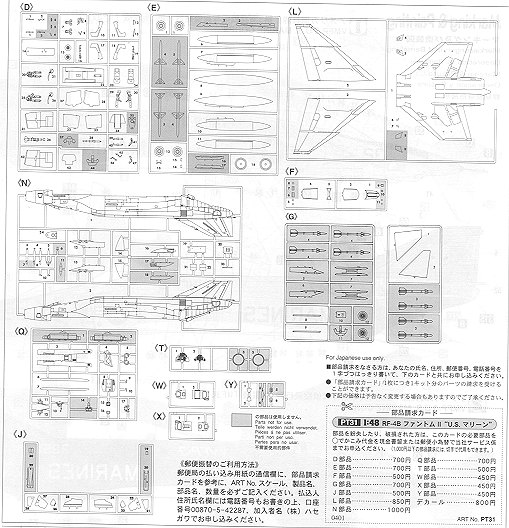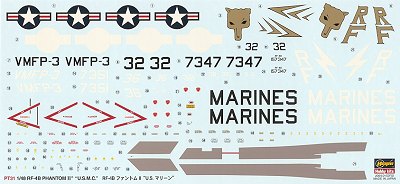
|
KIT: |
Hasegawa 1/48 RF-4B Phantom II |
|
KIT # |
07231 (Pt 31) |
|
PRICE: |
$39.95 MSRP |
|
DECALS: |
Two options |
|
REVIEWER: |
Scott Van Aken |
|
NOTES: |

|
HISTORY |
All remaining aircraft were upgraded in the late 1970s to similar standards to the F-4N/S, but there was no designation change as there was to the F-4B/J.
|
THE KIT |

As with the earlier RF-4E kit, this one is a mixture of new and old sprues. There are sprues from the F-4B/N as well as from the F-4E/F and EJ in addition to the generic sprues and ones specially made for the RF-4 series. The good news is that this is a true RF-4B. The bad news is that this one is for the last 10 made from F-4J airframes. That means the wing hump, bulged gear doors and wider wheels. It severely limits what can be built as you cannot do any Vietnam war aircraft as I don't think any of these made it into the front lines. In other words, you have to be very careful to stay within the 157xxx buno range when devising markings for this one. I'd hope that an early RF-4B would be in the works with the flat wing and I'm sure that if you want to kit bash this with the B/N kit, you could have your wish, but I'd have rather seen the early one in a single kit. The only all-new sprue is the X sprue with the different lower camera window.
The result of this sprue swapping is that there will be
some bits with raised panel lines, most with engraved and there will
undoubtedly be a problem with panel line matching between the fuselage and
wing sections as I discovered when doing the RF-4E. What is new with this
kit is a new bit on the clear sprue that includes a more angular nose
section and the V shaped camera window on the underside. With this kit,
you'll have to remove the control stick mount from the aft cockpit and
you'll also have to fill in all the slime lights on the fuselage and tail.
There are also a few other 'fill this' 'remove this' 'open this'
requirements, but nothing unusual. While it looks as if you might be able to do an RF-4C, I'm not positive if the instrument panels/side consoles are
correct for that variant. It will take some research to find out for sure,
but it looks hopeful for those of you who can't wait a few more months for
the definitive kit.
to do an RF-4C, I'm not positive if the instrument panels/side consoles are
correct for that variant. It will take some research to find out for sure,
but it looks hopeful for those of you who can't wait a few more months for
the definitive kit.
Markings are provided for two aircraft. Both aircraft are from VMFP-3. The box art aircraft is a nice green tailed version in the light gull grey and white scheme. The other is the specially painted retirement aircraft in gloss black when VMFP-3 was disestablished in 1993. It is hoped that this kit will engender some of the low-viz schemes carried by VMFP-3 during its long service life. Decals appear to be a bit more usable as the whites are actually closer to white than older sheets. The ones for the RF-4E worked very well so these should be no different.
|
CONCLUSIONS |
I have to say that I'm disappointed that this one isn't an early B. It severely limits what markings can be used and I do have several old Superscale sheets for those early birds that I could use. Conversely, it seems that one could do an RF-4C, but I'll hold off for the 'legit' kit on that one. Regardless of how I feel about the decision on doing a kit for which there are only 10 planes built, it is nice to see it and probably part of Hasegawa's plans to kit the 'less desirable' versions first before bringing out what we all want.
Kit courtesy of a surge of impulse buying at the dealers tables!
|
REFERENCES |
McDonnell/Douglas Aircraft since 1920, vol 2, by Rene J Francillon
If you would like your product reviewed fairly and fairly quickly by a site that has over 250,000 visitors a month, please contact me or see other details in the Note to Contributors.